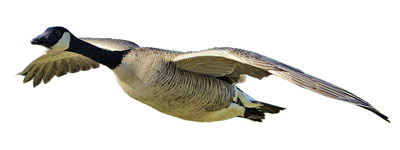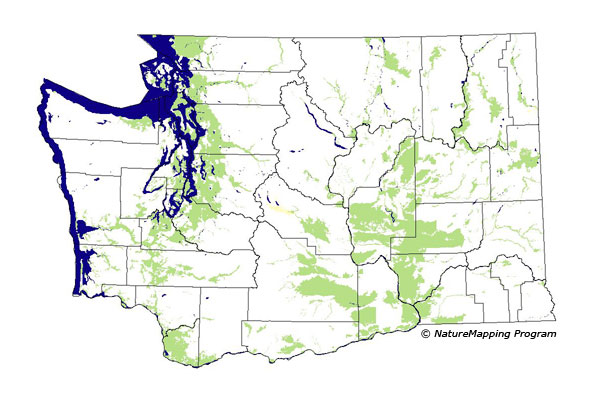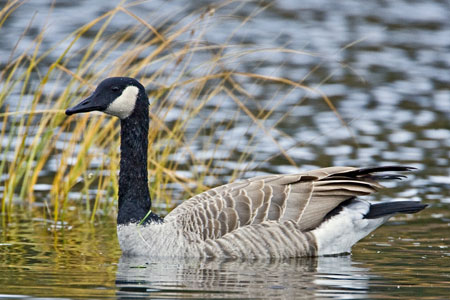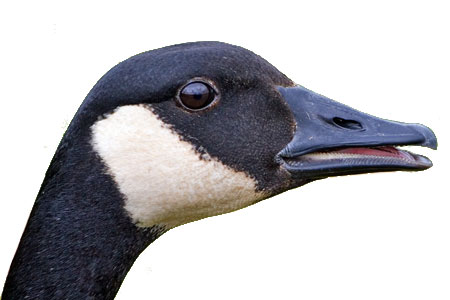
NatureMapping Animal Facts
Canada Goose



|
Canada Goose (Branta canadensis)  Description:
The Canada Goose is well known for flying in a distinctive V-formation, its loud "honk" and its unmistakable looks. A Canada Goose
gander can reach 14 pounds and can have a wing spread of up to 5 feet.
Description:
The Canada Goose is well known for flying in a distinctive V-formation, its loud "honk" and its unmistakable looks. A Canada Goose
gander can reach 14 pounds and can have a wing spread of up to 5 feet.
Males and females have very similar plumage: head and neck are black, with bold white cheek patch. body grey-brown; feathers u nder tail white. The call is a series of loud "honks" when flying. 
Range / Habitat: The most familiar and widespread goose in North America, the Canada Goose can be found in all kinds of water all across the continent, from the tundra to the Gulf Coast. Some populations have become resident in urban areas, and are now coming into conflict with people. This species is locally common throughout the lowlands of the state in the wetlands and waterways, cities, and agricultural areas (except the extensive dryland fields of eastern Washington). Their habitat preference includes ponds, lakes, rivers, grain fields, fresh and saltwater marshes. Click the range map to learn more about the distribution of the Canada Goose in Washington. Diet: The Canada goose favors aquatic plants, small aquatic animals, grass, and grains. Nesting: The nest is a large mound of vegetation such as grass and cattail stems lined with down. It is usually located within sight of water. 4 to 7 white eggs make up a typical clutch and incubation is done solely by the female. The gander (male) zealously guards the nest and will attack any intruders. Incubation takes 25 to 30 days and the goslings are led to water within a day after hatching. The goslings stay with the parents until the following spring. 
Behavior: The gander is a fierce defender of his mate and offspring, and will charge any suspected enemy, even one as large as an elk. Mated pairs can be together as long as 20 years. Migration: The geese migrate to places where it is warmer and where food is available. Canada Geese migrate in large groups in the familiar V-formation. Scientists think that the reason these birds fly in the V-formation is due to what is known as the ‘drafting effect’. Basically, this helps the birds to conserve their energy while flying long distances. The leader in the front splits the air current (and at the same time uses the most energy). When he tires, he moves to the back then another goose takes over the lead spot. Migrating birds usually follow the same path every year. These paths are called routes or flyways. The flyways used by the Canada Goose are : the Atlantic flyway (along the east coast of North America), the Mississippi flyway (named after the river), the Central flyway (along the Rocky Mountains) and the Pacific flyway (west of the Rockies). Some migratory populations of the Canada Goose are not going as far south in the winter as they used to. This northward range shift has been attributed to changes in farm practices that makes waste grain more available in fall and winter, as well as changes in hunting pressure and changes in weather.
Did you know?
Animal silhouettes available to purchase »
Photos: Natures Pics Photos: Canada Goose photo gallery Videos: Canada Goose videos More Information: Canada Goose - All About BirdsHome | About Us | How to Participate | Biodiversity Modules | Projects | Maps | News | Resources |